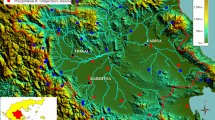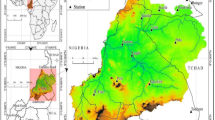Abstract
Understanding and assessing hydroclimate changes is essential to provide reliable information in developing countries such as Senegal in order to guide adaptation strategies. In this work, we have examined the projected changes in temperature and precipitation over the six eco-geographical zones in Senegal. Furthermore, we have assessed the river flow changes in the three major river basins (Casamance, Gambia, Senegal). Climate simulations from the Coupled Model Intercomparison Project Phase 6 (CMIP6) were analyzed. The ensemble mean of the climate models projects a continued increase in mean, minimum and maximum temperatures across Senegal (up to more than 4 ℃ in the long term under the SSP5-8.5 scenario). The projected warming is greater in eastern Senegal and the Sylvo-pastoral zone. As for rainfall, it is characterized by very high interannual variability; the projections show decreasing trend from 2015 to 2100. The groundnut basin is the most area affected by the decrease in rainfall (24%). However, slight humidity conditions are projected for the near future (2021–2040). The downward trend of rainfall is much more pronounced around 2045 to 2100. In addition, we found a slight increase in extreme wet events that are more marked in the near future. This could increase the risk of flooding in urban and peri-urban areas. Moreover, future flows are strongly impacted by climate change. Thus, the stations of Kolda (Casamance River), Gouloumbou (Gambia River) and Kidira (Senegal River) could experience a slight increase in flow rates (up to 20%) by 2030; while by 2060 and 2100, a decline of about 40% is projected. Our findings can help the water managers and decision-makers to better plan their adaptation measures.
Access this chapter
Tax calculation will be finalised at checkout
Purchases are for personal use only
Similar content being viewed by others
References
Agyekum, J., Annor, T., Quansah, E., Lamptey, B., Okafor, G.: Extreme precipitation indices over the Volta Basin: CMIP6 model evaluation. Sci. Afr. 16, e01181 (2022). https://doi.org/10.1016/j.sciaf.2022.e01181. ISSN 2468-2276
Akinsanola, A.A., Zhou, W.: Projections of West African summer monsoon rainfall extremes from two CORDEX models. Clim. Dyn. 52, 2017–2028 (2019). https://doi.org/10.1007/s00382-018-4238-8
Almazroui, M., Saeed, F., Saeed, S., et al.: Projected change in temperature and precipitation over Africa from CMIP6. Earth Syst. Environ. 4, 455–475 (2020). https://doi.org/10.1007/s41748-020-00161-x
Basak, J.K., Titumir, R.A.M., Biswas, J.K., Mohinuzzaman, M.: Impacts of temperature and carbon dioxide on rice yield in Bangladesh. Bangladesh Rice J. 17(1&2), 15–25 (2013)
Cook, P.A., Black, E.C.L., Verhoef, A., Macdonald, D.M.J., Sorensen, J.P.R.: Projected increases in potential groundwater recharge and reduced evapotranspiration under future climate conditions in West Africa. J. Hydrol. Reg. Stud. 41, 101076 (2022). https://doi.org/10.1016/j.ejrh.2022.101076
Dembele, M., et al.: Contrasting changes in hydrological processes of the Volta River Basin under global warming. Hydrol. Earth Syst. Sci. 26(5), 1481–1506 (2022). https://doi.org/10.5194/hess-26-1481-2022
Engelbrecht, F., Adegoke, J., et al.: Projections of rapidly rising surface temperatures over Africa under low mitigation. Environ. Res. Lett. 10, 085004 (2015). https://doi.org/10.1088/1748-9326/10/8/085004
Faye, A., Akinsanola, A.A.: Evaluation of extreme precipitation indices over West Africa in CMIP6 models. Clim. Dyn. 58, 925–939 (2022). https://doi.org/10.1007/s00382-021-05942-2
Garland, R.M., et al.: Regional projection of extreme apparent temperature days in Africa and the related potential risk to human health. Int. J. Environ. Res. Public Health 12, 12577–12604 (2015). https://doi.org/10.3390/ijerph121012577
Hass, A.L., Ellis, K.N., Mason, L.R., Hathaway, J.M., Howe, D.A.: Heat and humidity in the city: neightborhood heat index variability in a mid-sized city in the Southeastern United States. Int. J. Environ. Res. Public Health 13, 117 (2016). https://doi.org/10.3390/ijerph13010117
IPCC. Changements climatiques 2014: Rapport de synthèse. Contribution des Groupes de travail I, II et III au cinquième Rapport d’évaluation du Groupe d’experts intergouvernemental sur l’évolution du climat [Sous la direction de l’équipe de rédaction principale, R.K. Pachauri et L.A. Meyer]. GIEC, Genève, Suisse, p. 16 (2014)
Martinez-Villalobos, C., Neelin, J.D.: Regionally high risk increase for precipitation extreme events under global warming. Sci. Rep. 13, 5579 (2023). https://doi.org/10.1038/s41598-023-32372-3
Mbaye, M.L., Sylla, M.B., Tall, M.: Impacts of 1.5 and 2.0 ℃ global warming on water balance components over Senegal in West Africa. Atmosphere 10(11), 712 (2019). https://doi.org/10.3390/atmos10110712
Mbaye, M.L., Sy, K., Faty, B., Sall, S.M.: Hydroclimate analysis under 1.5 and 2 ℃ global warming in the Faleme river basin. In: Thorn, J.P.R., Gueye, A., Hejnowicz, A.P. (eds.) InterSol 2020. LNICSSITE, vol. 321, pp. 121–133. Springer, Cham (2020a). https://doi.org/10.1007/978-3-030-51051-0_9
Mbaye, M.L., Sy, K., Faty, B., Sall, S.M.: Modeling the impact of 15 and 20 ℃ global warming on the hydrology of the Faleme river basin (West Africa). J. Hydrol. Reg. Stud. 31, 100719 (2020b). https://doi.org/10.1016/j.ejrh.2020.100719
Mbaye, M.L., Bodian, A., Kimambo, O.N., Rouamba, F.I., Gaveta, E.: Analyses of past extremes precipitation-evapotranspiration indices over Sub-Saharan countries. J. Extreme Events 08(04), 2250002 (2021). https://doi.org/10.1142/S2345737622500026
Mohino, E., Rodríguez-Fonseca, B., Losada, T., et al.: Changes in the interannual SST-forced signals on West African rainfall. AGCM intercomparison. Clim. Dyn. 37, 1707–1725 (2011). https://doi.org/10.1007/s00382-011-1093-2
Myhre, G., Alterskjær, K., Stjern, C.W., et al.: Frequency of extreme precipitation increases extensively with event rareness under global warming. Sci. Rep. 9, 16063 (2019). https://doi.org/10.1038/s41598-019-52277-4
NASAC: Climate Change Adaptation and Resilience in Africa: Recommendations to Policymakers, Network of African Science Academies (2015). https://nasaconline.org/index.php/2016/09/12/climate-change-adaptation-and-resilience-in-africa-recommendations-to-policymakers-2
Niang, I., et al.: Africa. In: Barros, V.R., et al. (eds.) Impacts, Adaptation, and Vulnerability. Part B: Regional Aspects. Contribution of Working Group II to the Fifth Assessment Report of the Intergovernmental Panel on Climate Change, pp. 1199–1265. Cambridge University Press, Cambridge (2014). https://doi.org/10.2134/agronj2010.0303
Nicholson, S.E.: The West African Sahel – a review of recent studies on the rainfall regime and its interannual variability. ISRN Meteorol. 2013, 1–32 (2013). https://doi.org/10.1155/2013/453521
O’Neill, B.C., et al.: The roads ahead: narratives for shared socioeconomic pathways describing world futures in the 21st century. Glob. Environ. Chang. 42, 169–180 (2017). https://doi.org/10.1016/j.gloenvcha.2015.01.004
Osima, S., et al.: Environ. Res. Lett. 13, 065004 (2018). https://doi.org/10.1088/1748-9326/aaba1b
Rameshwaran, P., Bell, V.A., Brown, M.J., Davies, H.N.: Historical (1950-2014) and projected (2015-2100) hydrological model (HMF-WA) estimates of monthly mean and annual maximum river flows across West Africa driven by CMIP6 projected climate data. NERC EDS Environmental Information Data Centre (Dataset) (2022). https://doi.org/10.5285/346124fd-a0c6-490f-b5af-eaccbb26ab6b
Riahi, K., et al.: The shared socioeconomic pathways and their energy, land use, and greenhouse gas emissions implications: an overview. Glob. Environ. Chang. 42, 153–168 (2017). https://doi.org/10.1016/j.gloenvcha.2016.05.009
Salack, S., Sarr, B., Sangare, S.K., Ly, M., Sanda, I.S., Kunstmann, H.: Crop-climate ensemble scénarios to improve risk assessment and resilience in the semi-arid regions of West Africa. Clim. Res. 65, 107–121 (2015)
Saley, I.A., Salack, S.: Present and future of heavy rain events in the Sahel and West Africa. Atmosphere 14, 965 (2023). https://doi.org/10.3390/atmos14060965
Taïbi, A.N., Kane, A., Bourlet, M., Lorin, M., Ballouche, A.: The Senegal River, a disturbed lifeline in the Sahel. In: Wantzen, K.M. (ed.): River Culture – Life as a Dance to the Rhythm of the Waters, pp. 79–113. UNESCO Publishing, Paris (2023). https://doi.org/10.54677/YRPT3013
Todzo, S., Bichet, A., Diedhiou, A.: Intensification of the hydrological cycle expected in West Africa over the 21st century. Earth Syst. Dyn. 11, 319–328 (2020). https://doi.org/10.5194/esd-11-319-2020
Zhao, T., Dai, A.: CMIP6 model-projected hydroclimatic and drought changes and their causes in the twenty-first century. J. Clim.Clim. 35(3), 897–921 (2022)
Acknowledgements
We would like to thank the Staff of the Laboratoire d’Océanographie, des Sciences de l’Environnement et du Climat (LOSEC) at the University Assane Seck of Ziguinchor where this work has been done. We thank also the DGPRE (Direction de la Gestion et de la Planification des Ressources en Eau) for proving the river discharge data.
Author information
Authors and Affiliations
Corresponding author
Editor information
Editors and Affiliations
Rights and permissions
Copyright information
© 2024 ICST Institute for Computer Sciences, Social Informatics and Telecommunications Engineering
About this paper
Cite this paper
Mbaye, M.L., Faye, B., Dieye, B., Gaye, A.T. (2024). Projected Hydroclimate Changes over Senegal (West Africa). In: Seeam, A., Ramsurrun, V., Juddoo, S., Phokeer, A. (eds) Innovations and Interdisciplinary Solutions for Underserved Areas. InterSol 2023. Lecture Notes of the Institute for Computer Sciences, Social Informatics and Telecommunications Engineering, vol 541. Springer, Cham. https://doi.org/10.1007/978-3-031-51849-2_13
Download citation
DOI: https://doi.org/10.1007/978-3-031-51849-2_13
Published:
Publisher Name: Springer, Cham
Print ISBN: 978-3-031-51848-5
Online ISBN: 978-3-031-51849-2
eBook Packages: Computer ScienceComputer Science (R0)




